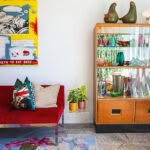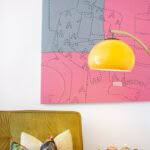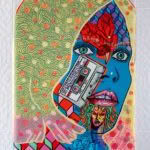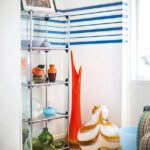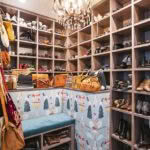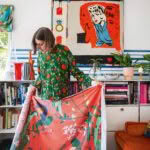This Auckland vintage collector simply can’t throw away beautiful things
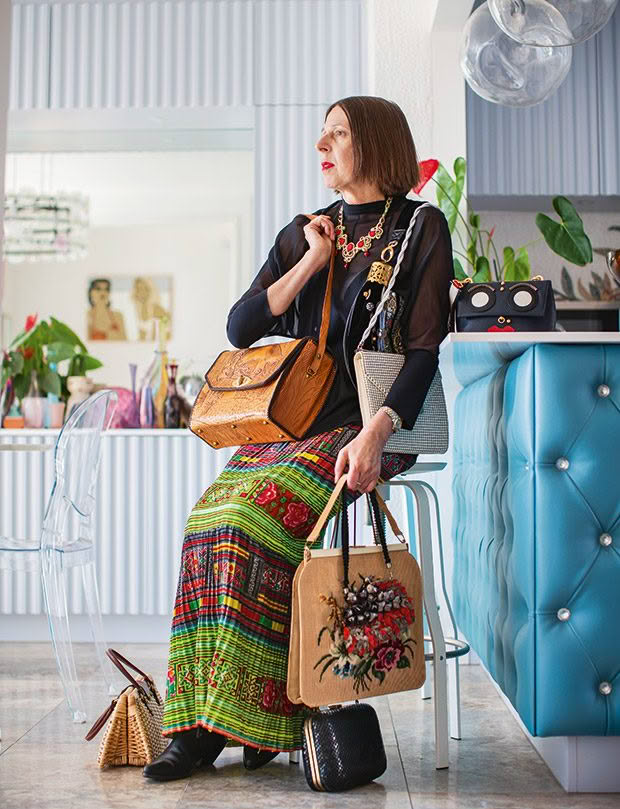
A fascination with handbags keeps Christine Smith busy while traveling. She found the hand-tooled leather bag (on her right shoulder), in a secondhand shop in Paeroa.
A lifetime love affair with apparel enters a new phase with the collector becoming the creator.
Words: Kate Coughlan Photos: Tessa Chrisp
Christine Smith has a hat that looks just like a hamburger on a plate. No, really, she does. Another one resembles a spooky face that could have been painted by artist Tony Fomison. A visage for wearing as headgear? Why not? Her little red teacup-and-saucer bonnet doesn’t speak of art for the bonce; more of laughs for a fun day out.
She’s worn these hats — and many others just as notable — when watching the horses race at Flemington in Melbourne and at Randwick in Sydney, a city in which she lived for many years. She had a friend who was mad-keen on horse racing and, as Christine is mad-keen on dressing up, they made the perfect duo on race day.
- She loves the pastel colours and sculptural shapes of her glass collection, begun 20 years ago. “I mainly collect Murano [from the island off Venice], and I have several pieces from the New Zealand glassmaker, Höglund Glass. Glass is not utilitarian; it has no purpose at all. So I admire it for its beauty alone.”
- The yellow arc lamp, dating from the 1970s, came from a now-gone-and-lamented secondhand shop on Manukau Road, Epsom. The artwork, by Australian artist Shannon Field, is an embroidered blanket called The Debt Collector. It amuses Christine that the debt collector appears to have one foot in a rubbish bin
This now-about-to-semi-retire securitization professional isn’t into mass-produced clothes. So whatever she paired with a hat, one can be sure it wasn’t an off-the-rack, new-season special from a chain store.
A collection from a lifetime love affair with beautiful and interesting apparel occupies two once-were-bedrooms; clothing in one room and handbags, shoes, hats and – the fastest-growing addition to the collection – scarves in another. In these rooms are such items as 1970s jumpsuits discovered at a Paris flea market (another city in which she lived for many years), minidresses found in a London bazaar (also her home for a few years) and many more hats and shoes. Oh, the shoes — seldom vintage but always treasured and saved. Such fun.
The first handbag she ever purchased was a Dior clutch; it was the 1970s, she was a teenager on holiday in “exotic” French New Caledonia where the temptations of duty-free shopping called to her like a siren. Designer items were not available in New Zealand in those days. She recalls the excitement of owning a thing of beauty before having a designer bag became pretty standard. The Dior clutch wasn’t the first handbag she loved. No, that was a repurposed treasure from her grandmother’s youth. She still has one of her grandmother’s bags today, alongside the Dior clutch.
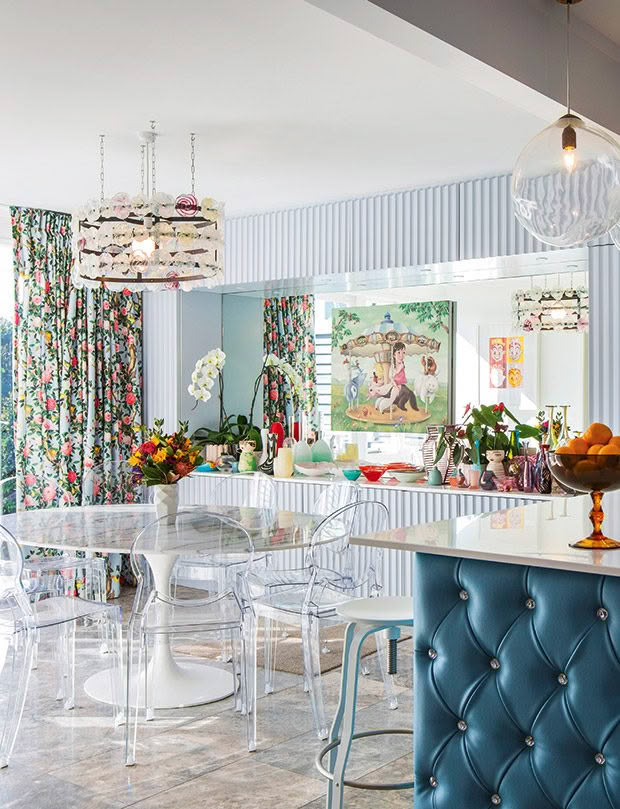
Although the dining area is not large, Christine comfortably (and regularly) seats 10 for dinner. Her friend, interior designer Neil McLachlan, solved the problem of a cramped kitchen and entranceway by removing walls to create a flowing space. She loves the mirror above her dining room cabinets for its reflections and dancing light. The clematis chandelier, specially made in an oval shape for her by Auckland artist Lynden Over, comes from the Black Door Gallery in Parnell.
Christine comes from a line of creative women with an eye for fashion. Her maternal grandmother, who emigrated from Croatia with her parents aged 12, had the skills of a couturier, fingers of a seamstress and made costumes for her daughters to wear at formal dancing competitions.
She kept the costumes in a dress-up box, which was young Christine’s “Aladdin’s cave” and, Christine thinks, what sparked her love of vintage clothing. Christine’s mother was also clever; a fabulous knitter. “It just seemed perfectly normal for me to make all my clothes as I was growing up,” she says.
From her grandmother’s vintage patterns, she customized dresses, jackets, skirts and coats. And, from her grandmother’s wardrobe, she sometimes plucked what she loved and wore it till it fell apart. “I started as a teenager, raiding the wardrobes at my mother’s and grandmother’s houses for things to wear. My friends and I loved their clothes, and I can recall very vividly a red velvet coat of my mother’s from the 1950s we adored. My friends treated it as common property. We wore it so much it fell apart.”
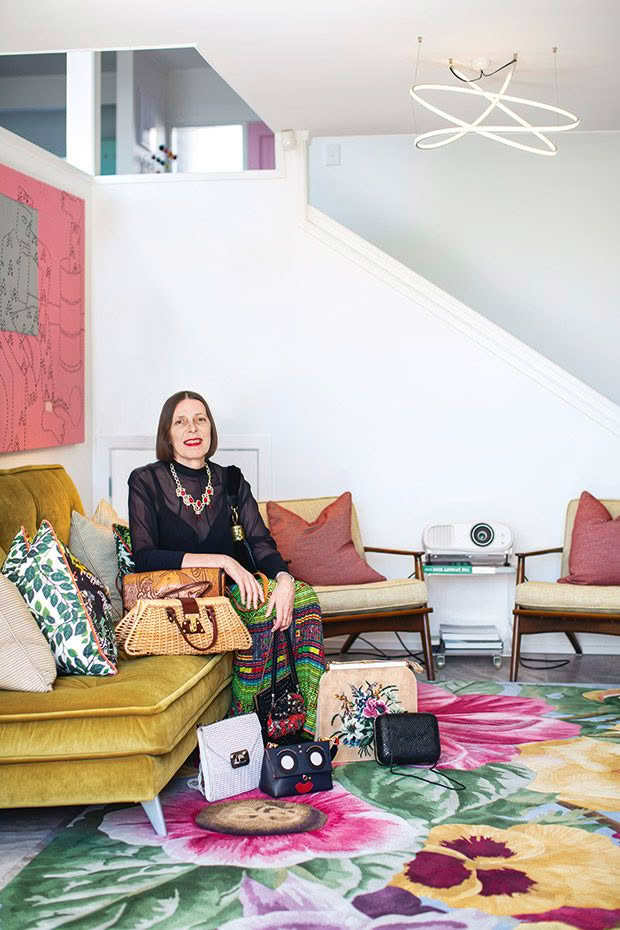
The vintage skirt Christine wears comes from the Asia Gallery and Vintage Fabric Emporium in Penrose, a place that gives her goosebumps. “It is in an old warehouse full of treasures and feels like it could it be in New York”
Had it not disintegrated, she would still have it. She can’t throw away beautiful things. “If it is gorgeous, it doesn’t stop being gorgeous. My philosophy is that if you get something that is unusual, and not really of a particular era, you will wear it forever. These garments are the ones people comment on and find interesting. I’ve never understood the ‘in and out’ concept of fashion.”
Once Christine finished an undergraduate degree in languages and art history at the University of Auckland, she was off to London like almost all of her 1980s generation. She didn’t have lofty career aspirations; she was rather more intent on having a good time in an exciting foreign city. And the doggedness with which she chased interesting clothing was the opposite of her approach to a career.
- Auckland artist Sam Mitchell, whose work Christine first saw in a portrait-painting class, paints in acrylic on perspex. Perspex is technically demanding as it dictates works must be painted backwards and in reverse, but the work is perfect for its location in a steamy bathroom.
- Christine’s father Harry Smith worked as a seal-maker for New Zealand ceramics company Crown Lynn, and the pale blue bowls on the top shelf were his Christmas gift from the company. She prizes the set of two bowls and a milk jug with little bobbles as handles. The large white and brown swirly vessel was originally a lamp base and is one of the first pieces of glass she bought. The tall orange vase, costing $100, came from the RSA Christmas antique fair at the War Memorial Hall in Auckland’s Dominion Road.
She landed a job at the Australian Embassy through a friend who was working as an English teacher at a French high school and used to work at the embassy during the school holidays. “He offered to put my name down for work. So I said OK, and I got offered a job at the Australian embassy in Paris.”
Initially, it was a clerical role and — even with a promotion to assistant to the Australian ambassador to the OECD – she didn’t see work as a career. “I was having a good time and enjoying myself, and I don’t regret that at all. It was amazing to be living in Paris and going out and having that life.”
What did excite her were the possibilities lurking in the famous flea markets of Paris, and she took a very disciplined approach to ensuring no treasure slipped past her. “I used to buy things like minidresses from the 1960s and 1970s, or longer pieces and cut them down. One of my most fabulous finds was an amazing red jacket, properly tailored with little weights in the seams and hem to keep it sitting perfectly. It is another piece I wore so much it eventually fell to pieces.”
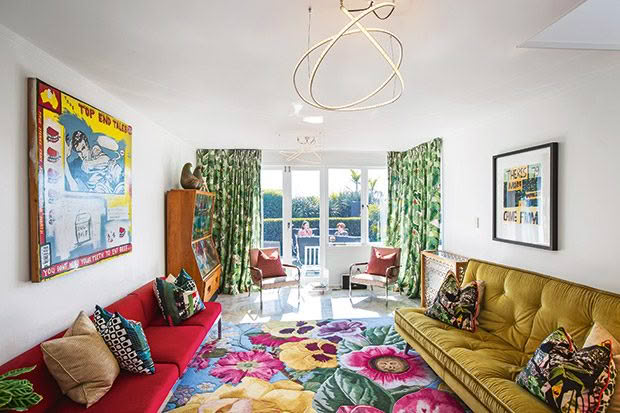
In the living area, Auckland designer Tanya Wolfkamp drew an A4-sized sketch for a floral rug for Christine after a dinner-party conversation. Then designer Neil and Tanya chose the varying shades for each flower. The finished rug, made from New Zealand wool, was dyed and woven in India.
But the greatest treasure from those days in Paris is a Jeanne Lanvin ballgown from the 1920s that Christine would, eventually, like to gift to a local museum even though she knows they are more interested in New Zealand fashion. “It is very simple; entirely made of layers of net. It was one of the most expensive items I have bought at a market; if the minidresses I was buying at the time cost $10 then this cost $100. I can’t quite recall the exact cost.
“The thing with such a dress is that it looks as good today as it did in the 1920s. I did wear it, yes. I wore it when my friend Kevin and I went to Madeira, and we had an evening at the casino, all very exciting and the dress looked very contemporary.”
- She doesn’t know how she ever survived without a room solely for shoes and handbags before she had one. The Shoe Room, lit by a crystal chandelier from Yvonne Sanders Antiques in Auckland’s Manukau Road, has a comfy seat from which to observe her many choices of footwear and handbags for the day. Nothing too “matchy-matchy” will be her choice.
- This silk, digitally printed with Christine’s design of Aotearoa flora and fauna by AUT’s Design Lab, is destined to be made into kaftans for a business she hopes to start. “I love kaftans as they are versatile, comfortable and last forever. My idea is to design the fabric and arrange the manufacture, and if a charity wishes to sell them, they can keep all the proceeds over the costs.”
After nearly a decade in Paris, soaking up the cultural life of the cinema, exhibitions and galleries she found so stimulating (and keeping Australia’s ambassador to the OECD organized), Christine moved to Sydney. There, she looked for a job in a French-speaking company to use her language skills. As luck would have it, a French-owned bank was setting up one of the first securitization businesses in Australia and, as she was in on the ground floor, as they say, she became something of an expert in the field.
Thus was born her accidental career — securitization. This complex branch of the finance world is not what might first spring to mind as an ideal career for a woman such as Christine. But she enjoyed it and found the work interesting and became so proficient that her goal of eventually moving to live once again in New Zealand came to pass when the ANZ offered her a job and helped her move back home.
- The new guest bathroom, previously the laundry, is so prettily decorated with a mural of fantastical birds prancing in a colourful wonderland, it doesn’t matter if the door is left open. The bedroom wallpaper, made in Transylvania, is equally beautiful. “I was in Ireland with Neil when we chose it.”
- The chandelier came from Yvonne Sanders Antiques. Lukeke also made the trio of hand-blown glass lights in the stairway.
- Christine began looking for an Auckland property while she was still living in Sydney and found this three-storey close-to-the-city townhouse on the first day. Thinking it must be too good to be true and that she’d better keep looking, she was relieved when a wise friend advised her to buy it immediately.
Thus she returned permanently to Auckland in 2008 and, after six years, was able to share the last years of her mother’s life when her mother moved in with her. “It was a privilege, those three years of my mother’s life,” she says. “It wasn’t at all what I expected living with an elderly woman to be like.
After her stroke, she was still capable physically but not so much mentally and wouldn’t have been able to cope on her own. She spoke her mind quite freely, more so than in her younger years, which was interesting. I am grateful I had the opportunity.”
Recently, Christine’s interest in creating rather than finding works of art prompted her to take drawing lessons. “It must be the closest thing to meditation – being so absorbed you don’t think about anything else.” She especially loved portraiture and fabric design, creating a scarf in screen-printed silk with portraits (by Christine) of Ashley Bloomfield and Jacinda Ardern. It is part of a Covid Collection being put together by the Auckland War Museum. “The thing about fabric design is that I can use what I design. It’s not simply a lot of pieces of paper needing to be stored as it would be if I’d taken up drawing. With fabric, I end up with something I can wear.”
Should this creative woman have been working in the arts all her life rather than organizing seating plans and plane tickets for the Aussie ambassador to the OECD and investigating assets and structuring securities for banks? “I’m not sure about that. I enjoyed my jobs – all of them, even if I wasn’t particularly career-oriented. I don’t regret one moment of those years having a good time. I doubt that I am talented in the artistic sense. I love it, that’s for sure. However, there’s a cartoon of two people with one heaping praise on the other for their artistic talent to which the response is: ‘It’s practice, it’s practice, it’s practice.’
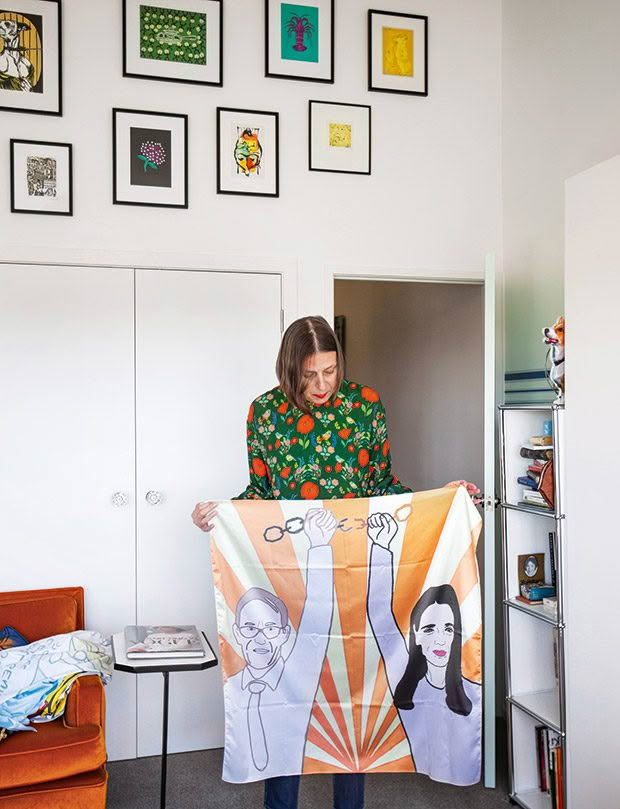
This silk scarf, designed during the lockdown, was inspired by Vietnamese Covid-19 propaganda Christine saw in The Guardian newspaper. She turned the rising sun into Edmonds’ Sure to Rise logo, and added portraits of Jacinda Ardern and Ashley Bloomfield “breaking the chain”. It is now part of the Auckland War Museum Covid Collection.
“Compared with where I started, I have improved, and a lot of it is learning to look at something; learning to see. Everyone has their style — it is like handwriting. The most fun thing is walking around the classroom after a lesson and looking at everyone else’s version of the same thing. You never see two vaguely similar representations.”
And it is the same when it came to the recent refurbishment of her Remuera townhouse, overseen by her friend from the Paris days (and well known to readers of NZ Life & Leisure), the now London-based interior designer Neil McLachlan. She and Neil set out to refresh her home rather than redecorate it.
“I don’t like wearing things that other people might have. Just like my furniture; I’m not keen on matchy-matchy new stuff, nor anything that anyone else might have. I’d rather refresh my old and loved things.” This philosophy of loving what is worth caring about is manifested in Christine’s growing concern about climate change. She recently enrolled in an online programme to learn and spread factual information about what is happening to the planet’s climate. In all areas of her life, what is old is new again, and what is beautiful is forever loved.
WHAT IS SECURITIZATION?
It is a banking mechanism by which assets are bundled together into a trust, which is then assessed for its quality and money loaned against it — the ultimate version of something being more significant than the sum of its parts.
THE CLIMATE REALITY PROJECT
The movie An Inconvenient Truth made Christine realize how much greenhouse gas emissions have grown in a short time. There is no doubt New Zealand already has evidence of climate change, she says. For example:
– The past decade was the warmest in New Zealand history.
– There have been more weather records broken in the past decade than at any other time in New Zealand’s history.
– Seven of the 10 warmest winters on record have occurred since 2000. The 2020 winter was 1.14°C above average, which now makes it the hottest winter on record.
– Since January 2017, New Zealand has not had a month of below-average temperatures.
“In August 2020, I got the opportunity to participate in the Climate Reality Leadership Corps Global Training to become a volunteer climate reality leader, one of more than 20,000 in 150 countries. The training was conducted by Al Gore and covers the science of climate change and the impacts of and solutions to the climate crisis. I aim to share this information with other people in the community and encourage them to support action to combat climate change.
“I’m worried what future we are leaving not only for children today but for every other species on the planet. For me, Rebecca Solnit summed it up best when she wrote: ‘Our work as climate activists arises from the recognition that acts have consequences, and consequences come with responsibilities, and we are responsible for the fate of this earth, for all living things now and in the future we are choosing with our actions — or inactions — in the present.’ climaterealityproject.org
Love this story? Subscribe now!
 This article first appeared in NZ Life & Leisure Magazine.
This article first appeared in NZ Life & Leisure Magazine.
